
BRIDGES IN COOPER COUNTY

COVERED BRIDGES
There once were five covered bridges in Cooper County: Crawford, Hurt, Connors, Shoemaker, and Big Lick. They all spanned the Petite Saline Creek. All the covered bridges were replaced many years ago by either metal or concrete structures.
Sadly, there are no known photos of any of the covered bridges in Cooper County. Above is a sketch of the covered bridge on highway 5 between Boonville and Billingsville by Florence Friederichs.
THE SWINGING BRIDGE
Pretend you are a child in 1930 and your dad is going to drive you across the brand-new swinging bridge for the first time. You are tall enough to see the steep hill going up to the bridge. The truck starts across the wide boards that don't look a bit safe. You dad is driving very slowly, but you can hear creaking and bumping of the metal against metal and the wooden planks. You press your nose against the passenger window and see the dirt-brown Lamine River looming 30 feet below. The trip across the 231-foot bridge seems to take too long. Then comes the stomach-churning descent on the other side. Your dad shuts off the engine and you hop out to watch vehicles behind you crossing. Some drivers turn around, not brave enough to venture across. When the bridge is empty, your dad reaches out his hand and says, “Let's walk across.” Your heart pounds at the thought. He grabs your hand, leading you up the steep hill. A gentle breeze causes the bridge to sway. You take one step and another until both feet are planted on one of the wooden boards. The world is moving beneath your feet, pitching and rolling, like a carnival ride.
Your dad tells you that farmers wanted a bridge built northwest of Pleasant Green, Missouri. They hired a man named Joe Dice, who had built other bridges like this one. A lot of local people helped build this bridge.
Your dad showed you two thick groups of wires that helped reinforce the structure. More than 300 individual wires make up each bunch. Two 22-foot-deep holes on each end of the bridge were filled with hand-made concrete that served to anchor the bridge.
Pretend now, it's 1994 and you are an old person. You see the bridge floor collapsed from heavy flooding, sinking into the river. It is no longer safe. The Cooper County Historical Society tries to save it, but the cost is too expensive. In 1996, you stand and watch as the bridge is removed from the Lamine River. You think back and can almost feel that bridge swaying beneath your feet.


Swinging Bridge near Lamine
Underside of Swinging Bridge over Lamine

Old Bridge over Lamine River
BOONVILLE HIGHWAY 40 BRIDGE

Boonville Bridge shortly after building in 1924.
Prior to 1924, the only way that travelers could cross the Missouri River between Boonville and New Franklin was by ferry. The first Boonville Highway 40 Bridge was dedicated on July 4, 1924. It was originally planned to be a toll span bridge, but the resourcefulness of Col. T.A. Johnson and Col. John Cosgrove was largely responsible for a quick change in plans. They were able to arrange for federal and state financial aid which made the bridge toll-free.
The bridge was opened on July 4, 1924 with a grand celebration in which the Mayors of Boonville and New Franklin each walked to the center of the bridge and shook hands.
The new bridge offered more freedom to motorists as the new bridge could now be used in all weather, whereas the ferries were halted in winter and during storms. Plus, commuters could travel across the river much more quickly than taking the ferries. Once the bridge was opened, there was no longer a need for the ferries and they ceased to operate.
The original steel frame bridge had a tongue-and-groove cypress wood floor. Unfortunately, the wood floor did not fit together perfectly and the unevenness caused the bridge to sway a bit when used. In freezing weather the boards became slick with ice and caused many accidents. Then, the wood began to rot and it was time to upgrade the floor.
In 1937 the wooden bridge floor was replaced with a corrugated steel floor, which also became slick in freezing wet weather. Salt was useless as it fell through the floor into the river. The unevenness of the corrugated steel grates also made staying in your own lane a challenge. The grates were especially hard on the older, narrow tires which often became stuck in the steel grates. People from both counties complained about the new floor, which was also very noisy.
Eventually a walkway on the side of the bridge was added for pedestrians.
Eventually, the two-lane bridge proved to be too narrow for larger, more modern cars and trucks and the complaints were too frequent.
The flood of 1993 was devastating to Boonville and New Franklin, and all along the Missouri River, as the flood waters eventually crested at 37.10 feet. It was the most massive flood in the Boonslick history, and the water stayed above flood stage for 49 days.

Boonville bridge 1924. From the Wayne Lammers collection

Grand Opening of the Boonville Bridge with
wooden floor July 4, 1924.
From the Wayne Lammers collection

This wooden floor was removed in 1936/37.
Pictured is Wayne Lammers with the corrugated floor.
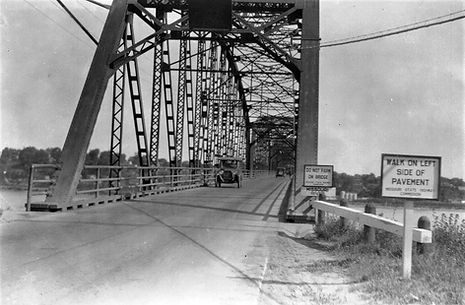


Hwy 40 near Fredrick Hotel
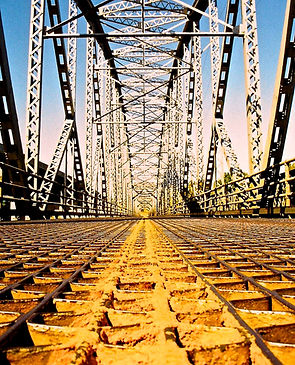
Old Boonville Hwy 40 Bridge Floor
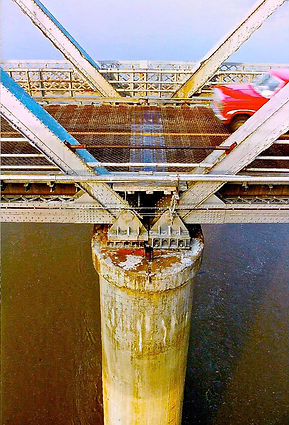
Old Hwy 40 Bridge

Boonville bridge with Sombart Mill. From the Wayne Lammers collection.
It was evident that a new bridge needed to be constructed with a much higher elevation, and also better adapted to modern transportation.
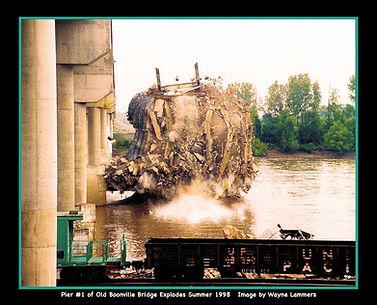
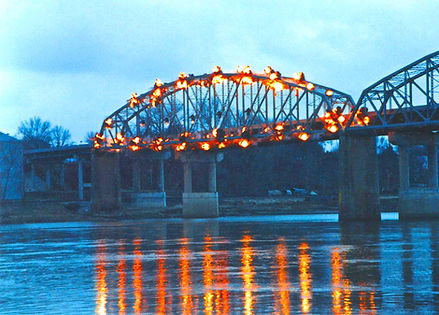
Blasting of the old Hwy 40 Bridge
Blasting of the old Hwy 40 Bridge

Construction of the new Hwy 40 Bridge

Construction Crew that built the new Boonslick Bridge
seen in the background in 1997.
Photo by Wayne Lammers
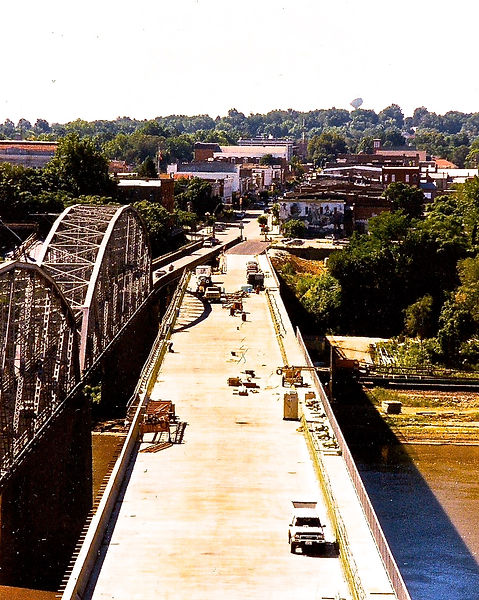
Building of the new Boonslick Bridge in 1998
with the city of Boonville at top.
Photo by Wayne Lammers
The new Highway 40 bridge, a 21-million-dollar project, was dedicated on September 9, 1997. The two driving lanes are each 12 feet wide with an 8-foot shoulder. There is also a six-foot Pedestrian walkway that is separated from the highway by a concrete barrier.
References:
Discover Cooper County by Looking Back by Ann Betteridge
Susan Fortman – “Taming a River: The Boonville Bridge


This is the first car to travel over the new Boonslick Bridge in 1998. The Driver is Kenneth Grotjan of New Franklin and Wayne Lammers is videotaping the event. Wayne Lammers worked out this event with the Engineer of the project. He is taking the photo and that's his truck behind the car. Mr. Grotjan owned a gas station on the north side of the bridge. He was so proud to be the first to drive over the bridge.
I-70 MISSOURI RIVER BRIDGE
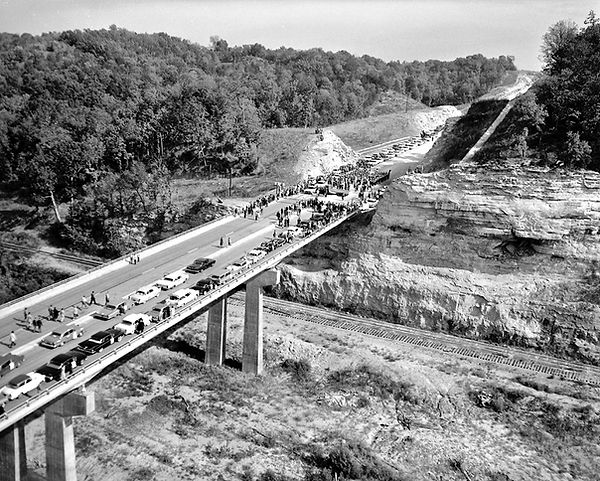
Dedication of the new I-70 bridge over the Missouri River
and MKT Railroad on October 8, 1960.
From the Wayne Lammers collection

Dedication of the I-70 bridge October 8, 1960

Dedication of the I-70 bridge October 8, 1960 from on top of cliff.
From the Wayne Lammers collection
